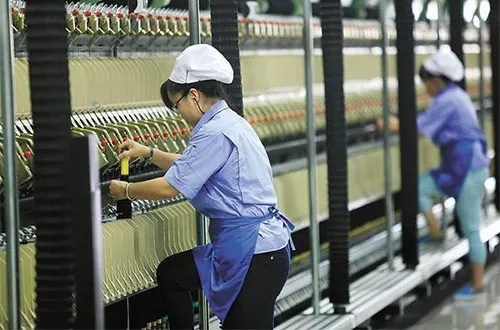Recycling Old Textiles:A Greener Future for Our Earth
Recycling old textiles is a crucial step towards creating a greener future for our planet. As the demand for new textiles continues to rise, the production of these materials often results in significant environmental impacts. By repurposing and reusing textile waste, we can significantly reduce our carbon footprint and mitigate the negative effects of excessive textile production. This process not only benefits the environment but also offers economic opportunities for individuals and communities. It allows for the creation of sustainable products that meet the needs of modern society while preserving natural resources. Additionally, recycling old textiles promotes social equity by providing economic incentives for those who have limited access to resources. Overall, the recycling of old textiles represents a practical solution to address the challenges posed by the textile industry's environmental impact.
In the world of sustainable development, one area that often gets overlooked is the recycling of old textiles. These materials, once used in clothing, home furnishings, and other items, can be repurposed into new products with minimal environmental impact. In this article, we'll explore the importance of textile recycling, the various methods available, and some inspiring examples of how it's being implemented around the world.

Why Recycle Old Textiles?
Old textiles, especially those made from synthetic fibers like polyester or nylon, are a significant contributor to landfill waste. They take hundreds of years to decompose, releasing harmful chemicals into the environment. By recycling these materials, we can significantly reduce our carbon footprint and protect our planet.
Methods of Textile Recycling
-
Sorting and Upcycling: The first step in recycling old textiles is sorting them by type. Different fibers require different treatment processes. For example, synthetic fibers like polyester and nylon can be melted down and reused as raw materials for new products. Wool and silk, on the other hand, can be processed into yarns or woven into fabrics.
-
Dyeing and Printing: Many textiles can be repurposed through dyeing and printing techniques. This process involves treating old textiles with new dyes or patterns to create new garments, accessories, or home decor items.
-
Weaving and Knitting: Old textiles can also be used to create new textiles. For instance, old clothes can be turned into rag rugs or patchwork quilts, while old textiles can be woven into new blankets or scarves.
-
Composting: Some textiles, especially those made from natural fibers like cotton or linen, can be composted. This process involves turning them into nutrient-rich soil amendments that can be used in gardens or farms.
-
Recovery and Reuse: Finally, some textiles can be recovered and reused in other ways. For example, old clothing can be converted into cleaning cloths or used as rags for household chores.
Case Studies
-
India: In India, the textile industry is a major contributor to the country's economy. However, many old textiles end up in landfills. To address this issue, the government has implemented programs to encourage the recycling of textiles. For example, the "Khadi" brand, which produces high-quality textiles using natural fibers, now uses recycled materials in their production.
-
Japan: Japan has a strong tradition of recycling and reusing materials. One such initiative is the "Renewal Project," where old textiles are collected from homes and businesses and then sent to factories where they are transformed into new products.
-
China: China is also making significant strides in textile recycling. For example, the "Green Textile" program encourages the use of eco-friendly materials in textile production, reducing the need for new textiles and promoting sustainability.
Conclusion
Recycling old textiles is not only good for the environment but also creates opportunities for economic growth and job creation. As more people become aware of the benefits of recycling, we can expect to see even greater efforts in this field. Let's work together to make our planet a cleaner, greener place for future generations.
随着社会经济的快速发展,废旧纺织品回收已成为环境保护和资源循环利用的重要议题,本篇旨在介绍废旧纺织品科学回收的重要性、现状及实践案例,同时通过英文案例说明来进一步阐述。

废旧纺织品科学回收的重要性
废旧纺织品科学回收不仅有助于减少环境污染,提高资源利用率,还能促进循环经济的发展,通过科学回收,可以减少废旧纺织品对环境的污染,降低资源浪费,同时推动循环经济的可持续发展。
废旧纺织品科学回收的现状
废旧纺织品科学回收已经成为一项重要的环保工作,许多国家和地区都建立了相应的法律法规,鼓励和支持废旧纺织品科学回收,随着科技的不断进步,废旧纺织品回收技术也得到了极大的提升。
废旧纺织品科学回收的实践案例
某城市废旧纺织品科学回收项目
该城市近年来大力推进废旧纺织品科学回收工作,他们建立了专门的回收站点,对居民和企业的废旧纺织品进行集中回收,他们还引入了先进的回收技术和设备,提高了废旧纺织品的回收率和再利用率,该城市还积极推动循环经济的发展,鼓励企业和社会各界参与废旧纺织品再生利用。
某纺织厂废旧纺织品回收改造项目
某纺织厂在废旧纺织品回收过程中,采用了先进的再生技术,对废旧纺织品进行了深度处理和再利用,他们将废旧纺织品转化为布料、纤维材料等再生产品,实现了废旧纺织品的再利用和资源化,这不仅降低了生产成本,还提高了产品的附加值和市场竞争力。
英文案例说明
在英文中,我们可以使用表格来进一步说明废旧纺织品科学回收的实践案例,以下是一个简单的英文表格:
废旧纺织品科学回收实践案例说明
| 项目名称 | 地区 | 废旧纺织品回收情况 | 回收技术 | 再生利用效果 | 环保效益 | 社会效益 | 未来展望 | | --- | --- | --- | --- | --- | --- | --- | --- | --- | | 某城市废旧纺织品科学回收项目 | 城市A | 成功建立回收站点,集中回收居民和企业废旧纺织品 | 先进的回收技术和设备 | 提高回收率和再利用率 | 减少环境污染,提高资源利用率 | 支持循环经济发展 | 未来将继续推进相关工作 | | 某纺织厂废旧纺织品回收改造项目 | 纺织厂B | 采用先进的再生技术,对废旧纺织品进行深度处理和再利用 | 再生技术 | 实现废旧纺织品的再利用和资源化 | 降低生产成本,提高产品附加值和市场竞争力 | 支持循环经济发展和资源循环利用 | 未来将继续推动再生利用工作 |
废旧纺织品科学回收是一项重要的环保工作,通过建立专门的回收站点、引入先进的回收技术和设备、推动循环经济的发展等措施,可以有效地实现废旧纺织品的科学回收和再利用,通过实践案例的分析,我们可以看到废旧纺织品科学回收的重要性和必要性,我们应继续加强废旧纺织品科学回收工作,推动循环经济的发展,为环境保护和资源循环利用做出更大的贡献。
Articles related to the knowledge points of this article:
How to Identify Textiles for Authenticity
Exploring the Best Discounted Textiles in Guangyuan A Shopping Guide



